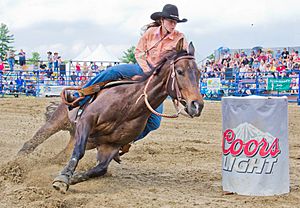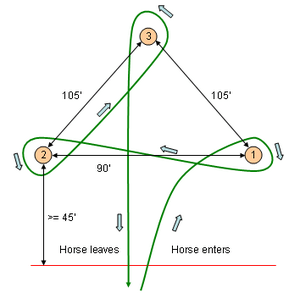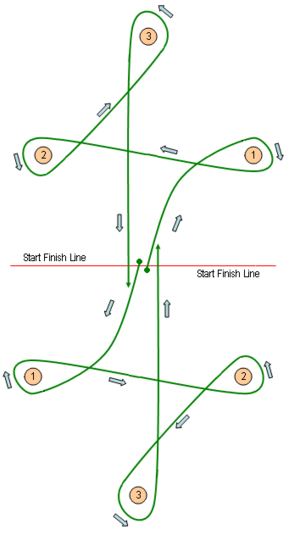Barrel racing facts for kids
 |
|
| Nicknames | Barrels, chasing cans |
|---|---|
| Characteristics | |
| Mixed-sex | Generally women and girls, some men and boys at local and youth levels |
| Type |
|
| Equipment | Horse, horse tack |
| Venue | Indoor or outdoor riding arena |
Barrel racing is an exciting rodeo sport where a horse and its rider race around three barrels. The goal is to complete a special cloverleaf pattern as fast as possible. This sport needs both a fast, athletic horse and a skilled rider. They work together to guide the horse safely around the barrels in a large arena. While it's often a women's event in professional rodeo, boys and girls also compete in youth and amateur races.
Contents
The History of Barrel Racing
Barrel racing started as a sport mainly for women. In the early days, riders would race in different patterns, like a figure-eight or a cloverleaf. Over time, the cloverleaf pattern became the standard because it was more challenging.
Many believe that the first barrel races were held in Texas. In 1948, a group of women from Texas created the Girls Rodeo Association (GRA). They wanted to make sure women had a place in the world of rodeo. The GRA was the first rodeo group just for women. It started with 74 members and about 60 events. In 1981, the GRA changed its name to the Women's Professional Rodeo Association (WPRA). Today, the WPRA still helps women compete in many rodeo events, but barrel racing is still the most popular. Many boys and girls, especially in country areas, also enjoy this sport.
How Modern Barrel Racing Works
Today, barrel racing is a big part of most rodeo shows. You can also find it at gymkhana or O-Mok-See events. These are usually amateur competitions where riders of all ages and skill levels can join. At these events, you might see other speed races too, like pole bending. Barrel racing at this level often groups riders by age. There are also "open" barrel races where anyone can compete, no matter their age or gender.
The main goal is to run the barrel pattern as quickly as you can. Times are measured in two ways. Sometimes, an electric eye (a laser system) records the exact time. Other times, a judge uses a flag to tell a timer when to start and stop the clock. Judges and timers are more common at local events. The clock starts when the horse and rider cross the starting line. It stops when they finish the pattern and cross the line again. Winning depends on how fit the horse is, the rider's skills, and the ground in the arena.

To start a barrel race, the horse and rider gallop into the arena at full speed. They cross an electronic timer beam. This beam starts the clock. The clock keeps running until they cross the beam again at the end of their run.
Modern barrel racing horses need to be fast, strong, and smart. They need strength and quickness to turn tightly around the barrels. A horse that can stay very close to the barrels and follow commands quickly will have the fastest times.
Rules and the Barrel Pattern
In barrel racing, the fastest time wins the race. If a horse and rider go off the pattern, they get a "no time" score and are disqualified. If a barrel is knocked over, there's a five-second penalty added to the time. This usually makes the time too slow to win. Riders have 60 seconds to complete the course once the time starts.
At professional rodeos, the arena ground is smoothed out after every twelve riders. The barrels must be 55-gallon metal barrels, closed at both ends, and have at least two colors. Riders in the National Barrel Racing Association (NBRA) must wear a western long-sleeved shirt (tucked in), western pants or jeans, a western hat, and boots. This dress code starts one hour before the competition.
Standard Barrel Distances
The barrel pattern has specific distances between the start line and the barrels. It also has distances between the barrels themselves.
Here are the usual distances:
- 90 feet between barrel 1 and barrel 2.
- 105 feet between barrel 1 and barrel 3, and between barrel 2 and barrel 3.
- 60 feet from barrels 1 and 2 to the score line (finish line).
In larger arenas, the maximum distance between barrels 1 and 2 is 105 feet. The maximum distance between barrels 2 and 3 (and 1 and 3) is 120 feet. Barrels 1 and 2 must be at least 18 feet from the sides of the arena. In smaller arenas, they can be closer, but never closer than 15 feet from the sides.
Barrel 3 should be at least 25 feet from the end of the arena. It should not be more than 15 feet further than barrels 1 and 2. If the arena is big enough, barrels should be 60 feet or more apart. In small arenas, the pattern should be made smaller to fit.
These distances are set by groups like the Women's Professional Rodeo Association (WPRA) and The National Intercollegiate Rodeo Association (NIRA).
The National Barrel Horse Association (NBHA) uses slightly different rules for patterns:
- At least 15 feet between each of the first two barrels and the side fence.
- At least 30 feet between the third barrel and the back fence.
- At least 30 feet between the time line and the first barrel.
Barrel Racing Technique
The way a rider approaches the first barrel is very important. The rider can choose to go to the left or right barrel first. Each turn around a barrel should be a smooth half-circle. It usually takes about three horse strides. When turning, riders use their inside leg for the first half of the turn and their outside leg for the second half.
After the first barrel, the horse must change its lead (how its legs move) to prepare for the second barrel. The rider needs to find the perfect spot to start the turn. The turn around the third barrel is in the same direction as the second barrel. After the third turn, the horse and rider race straight for the finish line to stop the timer.
As the horse gets ready to turn, the rider must be in the right position. They sit deep in the saddle and use their inside hand to guide the horse. The rider's leg on the inside of the turn stays close to the horse's side. This helps support the horse and guides it through the turn. For this sport, both the rider and horse need to be very fit. Being prepared helps prevent injuries to both.
Organizations and Competitions
Barrel racing has grown into a well-organized sport. The main group for professional female rodeo athletes is the Women's Professional Rodeo Association (WPRA). The WPRA holds over 800 events each year, with millions of dollars in prize money. The WPRA has twelve different circuits (regions). The best riders from each circuit compete at the NFR Open.
In the United States, two national groups focus only on barrel racing: the National Barrel Horse Association and Better Barrel Races. The WPRA also works with the Professional Rodeo Cowboys Association (PRCA). This allows women to compete in PRCA rodeos. Without this partnership, barrel racing would not be part of PRCA rodeos or the National Finals Rodeo (NFR). The WPRA world champion barrel racer is crowned at the NFR. Barrel racing has been part of the NFR since 1967.
Barrel Racing Horses
The American Quarter Horse is the most common horse breed used in barrel racing. These horses are known for their speed and quick turns.
A top-level barrel racing horse can be very expensive, sometimes costing $250,000 or more. The price depends on the horse's ability, intelligence, and desire to compete. The horse's family tree (breeding) also plays a big role in its price. The highest-selling barrel racing horse at a public auction in 2009 sold for $68,000.
Equipment for Barrel Racing
There are no specific bits required for barrel racing. A bit is part of the bridle that goes in the horse's mouth. Riders choose bits based on what their horse needs. Bits with longer shanks (sides) can help a horse stop faster. Bits with shorter shanks give more control for turns. Other equipment like Curb chains, nosebands, and tiedowns are used if needed.
Barrel racers usually use a single looped rein. This makes it easy for the rider to quickly grab the reins if they drop them. Leather reins are common, but they can get slippery when wet. Reins made of synthetic materials are also available.
A lightweight western saddle with a high front (pommel) and back (cantle) is best. The stirrups are hung forward to help the rider keep their feet in the right place. Riders often choose a saddle that is a bit smaller than they would normally use. Most importantly, the saddle must fit the horse well. Saddle pads and cinches (straps that hold the saddle on) are chosen based on the horse's size.
Camas Prairie Stump Race
The Camas Prairie Stump Race is a special type of barrel race. It's also a match race, meaning two horses race against each other at the same time. They race on identical courses on opposite sides of the start-finish line. The riders start next to each other, facing opposite directions. The first horse and rider to cross the finish line win. The races continue until only one horse is left. This race is not timed. It is one of five game classes approved by the Appaloosa Horse Club for horse shows. The rules say that racing is a tradition for the Nez Perce Native American people. However, it's not clear if this specific race comes from their traditions.
Preventing Injuries in Barrel Racing
To help prevent injuries, horses often wear protective boots on their front and back legs. Injuries can happen if horses or riders hit a barrel, fall during a sharp turn, or have an accident in the busy area near the arena gate. While equestrian helmets are not always worn by riders, more and more people are starting to use them. This became more common after a champion rider wore a helmet at the 2014 National Finals Rodeo.
The most common area for barrel horses to get injured is their fetlock joint (the joint above the hoof). Because of the tight turns and sudden speed changes, the horse's right front leg seems to have more stress. However, X-rays often show more problems in the left leg. Over time, some horses can develop osteoarthritis, which is a type of joint pain. There are not many studies on lameness (limping) in barrel horses, and most have only looked at horses that were already limping.
External links
- Women's Professional Rodeo Association
- International Professional Rodeo Association
- National Barrel Horse Association
- Better Barrel Races
- National Little Britches Rodeo Association
- National High School Rodeo Association
- National Intercollegiate Rodeo Association
de:Westernreiten#Barrel Race



